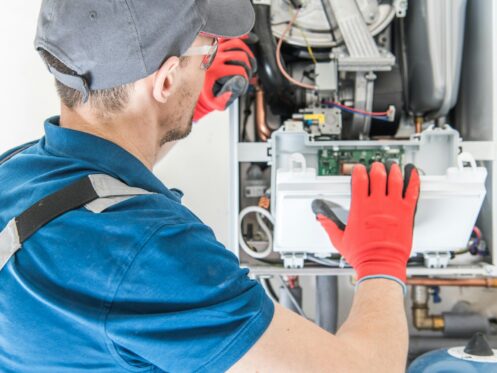When your furnace stops working the way it should, it can make your home uncomfortable and frustrating to live in, especially during cooler months in Lancaster. One of the most overlooked yet important parts of your heating system is the blower motor. This component is what pushes warm air through your home’s ducts and helps your entire system run properly. When the blower motor stops working or starts acting up, your house might not heat evenly or at all.
Even if the furnace itself is okay, a problem with the blower motor can keep that heat from ever reaching your rooms. If you’ve noticed weak airflow, sudden shut-offs, or even unusual sounds coming from your system, it’s worth finding out if the blower motor is the root of the problem. Knowing what signs to look for and understanding what can lead to blower motor failure will help you address issues quickly and avoid more serious damage.
Signs Of A Bad Furnace Blower Motor
When the blower motor isn’t working right, there are usually warning signs. Many homeowners in Lancaster experience one or more of these problems before their furnace stops pushing out warm air completely.
Here are the most common signs that the blower motor might be failing:
– Strange sounds: Loud banging, rattling, squealing, or buzzing noises from the furnace area can be signs the motor bearings or belts are worn down
– Weak airflow: If you notice reduced air coming out of your vents, even when the furnace is running, the blower motor could be losing power or failing altogether
– Air not reaching all rooms: Rooms farthest from the furnace not heating up may signal the blower isn’t moving air strongly enough through the ductwork
– Furnace turns on and off too often: Known as short cycling, this can happen when the blower motor isn’t able to circulate air efficiently, causing the system to overheat or shut down right after starting
– Blower doesn’t run at all: If warm air never leaves your furnace or you hear the furnace turn on but no air comes out, the blower motor could have stopped working entirely
Each of these symptoms points to an issue that shouldn’t be ignored. Sometimes the problem may seem small, like a high-pitched noise or slightly unstable airflow. But even small signs, when left unchecked, can turn into system-wide problems. One Lancaster homeowner found that their second floor never warmed up, even on chilly nights. Their system was running but not pushing air hard enough through the ductwork due to a worn blower motor. Once the motor was addressed, their comfort level quickly returned.
Ignoring the warning signs runs the risk of further damage, increased utility bills, and unnecessary stress. Staying alert to changes in how your furnace performs can save time and money while keeping your home comfortable throughout the heating season.
Why Furnace Blower Motors Fail
Understanding why blower motors fail can help you catch issues earlier and avoid repeat breakdowns. Most blower motor problems don’t start overnight. They result from a buildup of small issues over time.
Here are some of the most common causes of blower motor failure:
– Electrical issues: A tripped breaker, faulty wiring, or trouble with the control board can prevent the motor from turning on or functioning properly
– Dirt and dust buildup: Dirt can clog up the motor, causing parts to stick, overheat, or slow down. Lack of regular filter changes often leads to this kind of issue
– Overheating: Without enough airflow or when parts are blocked, the motor can overheat and burn out. Some systems involve thermal overload protectors, but these don’t always catch everything
– Worn bearings or belts: Parts inside the blower motor assembly wear down over time. Dry bearings or loose belts can affect performance and lead to larger mechanical problems
– Poor maintenance habits: Skipping filter replacement or yearly furnace inspections allows small issues to turn into costly repairs. Dirty filters can slow airflow, create extra strain, and reduce the overall lifespan of the motor
If a furnace filter is clogged, the blower motor has to work harder to pull in air. That creates more wear and tear on the motor and raises the chances of it overheating. Similarly, issues like dust-covered fan blades or loose wiring don’t seem like urgent problems but can quickly put a strain on the entire HVAC system.
Understanding what leads to blower motor issues gives you the upper hand in recognizing early trouble and avoiding inconvenient repairs during the colder months in Lancaster. Catching the symptoms early is key to keeping your home safe and warm. The next step is learning what actions you can take to verify the problem and why professional evaluation is the safest choice.
Troubleshooting Blower Motor Problems
If your home isn’t warming up the way it used to and you’re starting to suspect blower motor trouble, there are a few basic steps you can take before calling a professional. These steps won’t fully fix the problem, but they can help pinpoint what’s going wrong.
Try these checks first:
1. Inspect the air filter: A clogged air filter makes your motor work harder. Dirty filters block airflow and add strain to the system. If you haven’t changed your filter in over a month, it’s a good place to start.
2. Look at the circuit breaker: Open your breaker panel and see if the furnace switch has been tripped. If it has, flip it back on and see if the blower starts again. If it trips more than once, do not reset it repeatedly. That points to a deeper electrical issue.
3. Listen and observe: Turn the thermostat to heat and watch what happens. If the furnace starts but there’s no air movement, or if you hear humming or rattling, these are signs the motor isn’t engaging or is grinding due to wear.
4. Check for loose panels and screws: Vibration or unusual sounds may come from loose connections or parts inside the blower assembly. Rounded screws or misaligned panels can cause the whole assembly to shake during operation.
Even after these checks, blower motor problems are rarely easy to solve without proper training. If your system still isn’t working or something seems off, it’s time to have our professionals examine the issue. They can safely test motor amperage, capacitor function, belt tension, and wiring. This prevents further damage and ensures your system is running as it should.
Repair Or Replace? What To Expect From Service Calls
If a professional confirms the blower motor is behind your heating problems, the next step is deciding whether it should be repaired or replaced. Several factors determine which path is better.
Here’s what typically goes into the decision:
– Motor age: If the motor is nearing the end of its lifespan, replacing it can prevent frequent future breakdowns
– Extent of damage: Burned windings, broken shafts, or warped parts may not be worth repairing
– Availability of replacement parts: Some older motors may be hard to find parts for, which can delay repairs and increase overall cost
– System condition: If your furnace is very old, putting a new blower motor in may only be a short-term fix before bigger problems surface
In many cases, a repair is possible when the issue is minor—replacing a run capacitor, tightening connections, or replacing a fan belt. But if the motor is overheating regularly or making screeching noises, replacement is often a safer call. Replacing with a compatible, high-efficiency motor can help restore airflow, reduce noise, and increase system reliability during colder seasons in Lancaster.
Scheduled maintenance moving forward also helps you get more life out of a new or repaired motor. Cleaning the blower assembly, replacing filters on schedule, and checking voltage and amperage levels during annual service can prevent premature wear.
Restoring Comfort To Your Lancaster Home
Furnace blower motor problems do not go away on their own. They tend to get worse, especially when left running under strain. What starts as weak airflow can cascade into a system shutdown, leaving your home cold just when temperatures drop.
If something doesn’t sound or feel right with your system, waiting to act can lead to bigger repairs. Whether it’s a strange noise, weak airflow, or signs your blower isn’t running at all, having our technicians take a close look can help locate the issue fast and get things working smoothly again.
Your comfort shouldn’t be inconsistent in the middle of heating season. Lancaster homeowners rely on steady, even warmth, and when the furnace blower motor acts up, it becomes more than a small inconvenience. Prompt attention and experienced diagnostics are the best way to keep your HVAC system running strong and your household comfortable.
Experience dependable warmth with professional care from Affordable Air Inc. in Lancaster. Our technicians understand the challenges of an underperforming furnace and are ready to help restore your home’s consistent heat. Discover how our furnace services in Lancaster can improve your heating system’s efficiency with routine maintenance and timely repairs. For a quick estimate or to book a service visit, please contact us today.




